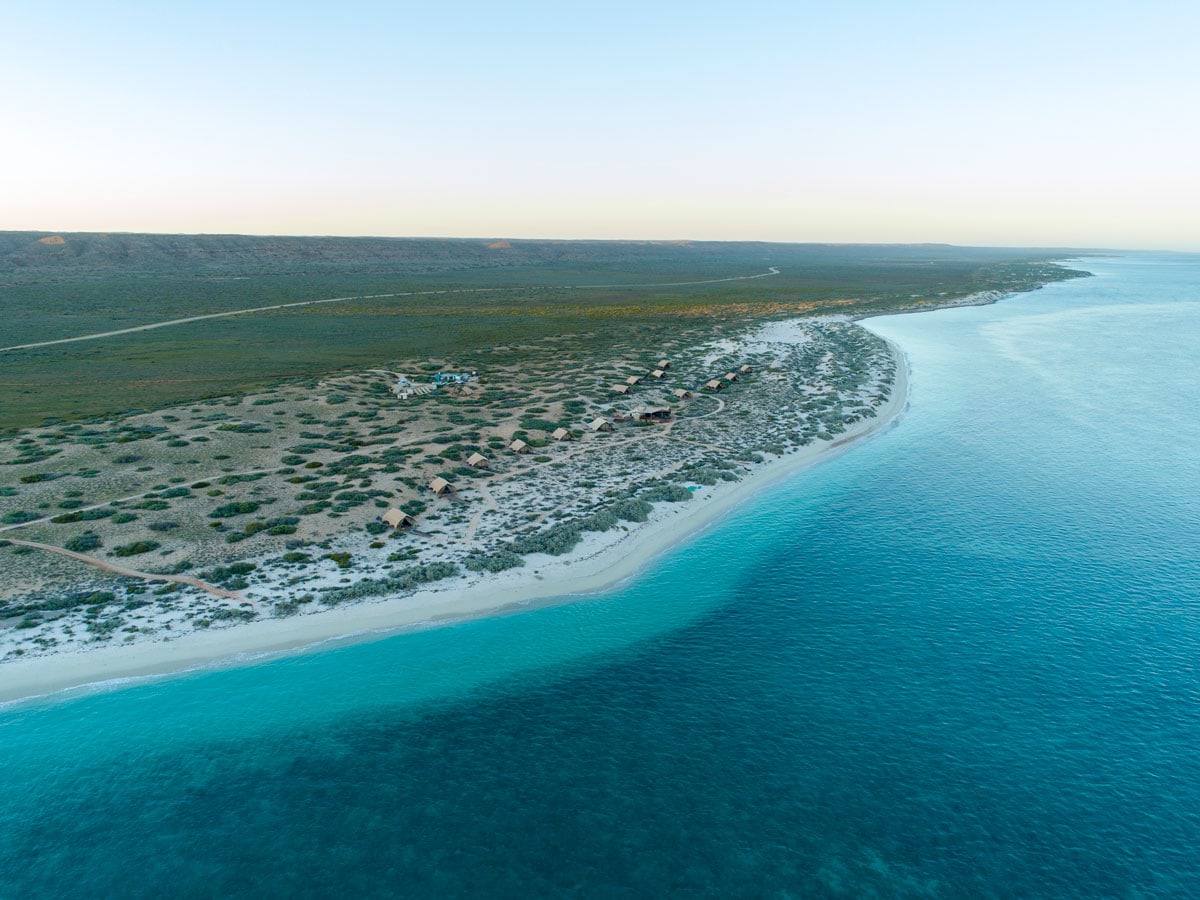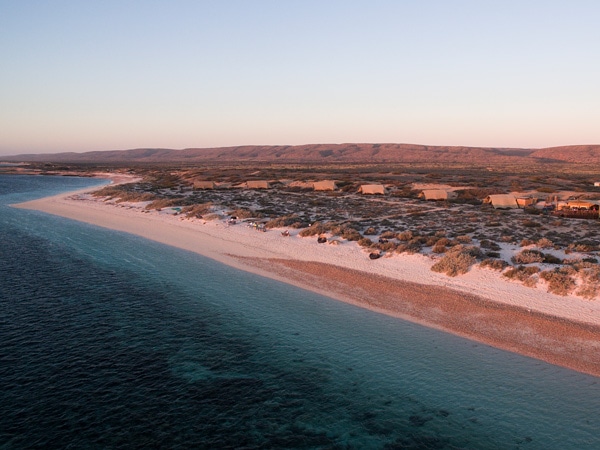10 July 2024
![]() 8 mins Read
8 mins Read

The soft glow of first light streams through the shaded mesh covering of my nature en suite. A palm-sized shell from the nearby beach adorns the ledge and a cool ocean breeze rushes through the gap in my tent, collecting strands of my hair as I splash water on my face to start the day. I’m suddenly super aware of how precious this finite resource is after three nights sleeping by the ocean on the sand dunes of Western Australia’s Cape Range National Park where they get 200 millimetres of rain a year – if they’re lucky.
Here, cocooned in a rustic eco-wilderness tent at Sal Salis Ningaloo Reef, I wake with the sunrise and fall asleep to the sound of the ocean crashing against the reef. No devices. No bright lights. No mobile or internet coverage. It’s the antithesis of my life in Sydney and it is rewiring me from the inside out.
This deep respect for the power of nature to completely undo you is what Sal Salis defines as its ‘experiential style of luxury’. Everything about the camp is designed to connect you to the environment and wildlife around you.
From the ocean-facing placement of its tents – built to capture the coastal breeze and create a channel for airflow – to its approach to light and noise pollution, allowing you to witness uninterrupted star-speckled skies, and of course its location alongside UNESCO World Heritage-listed Ningaloo Reef with its 500-plus species of fish, coral gardens and megafauna.
It also underpins the ethos of the Eco-Certified bush camp; its guiding principles of minimal impact and sustainability are reflected in the measures Sal Salis has taken to protect its environment: construction of the camp is above ground level to protect the flora and fauna, power is generated by solar, water usage is carefully managed to avoid weed growth, no waste material escapes into the surrounding ecosystem. Every detail has been thought of, even down to the reef-safe sunscreen and toiletries.

Stay under canvas at Sal Salis Ningaloo Reef.
Camp manager Leith Graham has spent the past 12 years managing remote lodges across the Top End. He left Seven Spirit Bay on the Cobourg Peninsula to manage Sal Salis earlier this year. Leith laughs when I comment on the camp’s remoteness. “This place isn’t remote; it has roads,” he says.

Sal Salis is in Australia’s wild, wild west.
“When we drove into town for the first time, I thought, ‘What have I done?’ because it was 50 degrees,” he says, shaking his head at the memory. The summer heat is one of the reasons Sal Salis is only open from mid-March to mid-November. But by the time we pull up at Graveyards Beach, you can tell this place has gotten under Leith’s skin. We’re here to see green sea turtles from a distance; it’s late September and hundreds upon hundreds of them gather to mate just offshore at this time of year.
I follow him up the side of a sand dune and the wind blows more fiercely the higher we climb. At the top, a perfect crescent-shaped stretch of sand greets turquoise waters filled with hundreds of turtles bobbing in the waves below. I soon realise several of them are bobbing in piles of three or four. The females mounted by multiple male turtles at a time. “It’s like you’ve fallen into a David Attenborough series, isn’t it?” asks Leith over the wind.

Snorkel with turtles from Sal Salis Ningaloo Reef. (Image: Justin Bumpstead)
Days start and end in the communal lodge, the beating heart of camp life. It’s here I find the daily included activities scrawled across the chalkboard; normally a combination of a guided snorkelling tour or a hike to nearby Mandu Mandu Gorge or Yardie Creek Gorge.

The exclusive Sal Salis is on the shores of Ningaloo Reef.
There’s also a 24-hour self-serve bar stocked with wine, beer, spirits and non-alcoholic beverages of all kinds from across Western Australia, as well as a barista-style espresso coffee machine and snacks lined up in jars for the taking.
I join the other guests each evening for canapés on the deck, where we gather to watch the sun slip into the ocean and the sky erupt into fiery hues of red and orange before the colour drains into darkness.

An aerial shot of Sal Salis, camouflaged in the striking landscape.
It’s also where new chef Paul Seymour (also joining from Seven Spirit Bay) whips up his five-star dining creations that wouldn’t be out of place in Sydney’s finest restaurants. Dinner steals the show: a three-course set menu paired with the state’s best wines. Think crab tortellini, crispy pork belly, seared scallops and lamb rump.
It’s not long before wild tales from the day’s adventures start to spill around the communal tables. I think back to earlier that day when I joined a Live Ningaloo tour of the reef.

Find enough relaxation time to switch off.
The pilot circling the reef above radios to say she’s spotted a whale shark nearby. Whale shark season is over, so this feels like an unexpected gift. I stand, gripping onto the rail as we race towards the sighting; one hand not enough to keep me steady. An explosion of water appears ahead of us. A humpback whale breaches and a calf half her size follows her lead; spiralling into the air and flopping back down with gusto.

Live Ningaloo offers interactions with whale sharks. (Image: Justin Bumpstead)
None of us, including the crew, can contain our excitement as unguarded squeals of delight ripple through the boat. Our skipper, Kurtis McGlennon, reluctantly pulls us away from the humpbacks at play – our turn to swim with the whale shark is fast approaching.
There are 15 operators with a licence to run swimming tours on the reef and Live Ningaloo is one of the lucky few. Now in position, four of us slip into the water after Katie Gates, our in-water guide and a marine biologist, following her lead as she directs us to kick into position.

Join Live Ningaloo Tours. (Image: Justin Bumpstead)
I stick my head underwater at Katie’s direction and, moments later, see a grey figure start to take shape in the distance. A seven-metre whale shark is now directly in front of me. I start swimming to keep up, its tail effortlessly propelling it through the crystal-clear waters of the reef. I’m mesmerised by the white spots scattered in intricate patterns across its back; shimmering as they catch streaks of sunlight.
“Stop swimming!” Yells Katie from above. Our time is up. I reluctantly watch it swim out of view.

Go deep down under at Ningaloo Reef. (Image: Justin Bumpstead)
I can still feel a fine coating of sand on my skin and see a light dusting of chalk-white dirt on my feet when I am waiting to collect my luggage at Sydney Airport. I’m reluctant to wash it away; it’s a welcome reminder of what we stand to lose if we keep our heads buried in the busyness of life.
As I stand watching the baggage carousel, I’m reminded of Leith Graham’s words, “The more people that know about Ningaloo, the more protected it will be.” I know exactly what he means.

Explore Cape Range National Park.
Exmouth’s Learmonth airport is the closest access point to Ningaloo Reef, located a little over an hour’s drive from Sal Salis. There are daily Qantas flights to Exmouth departing from Perth, with airport transfers available to pre-book for a fee through Sal Salis. Recently, Qantas also launched a twice-weekly direct flight from Melbourne to Exmouth during peak season.
Live Ningaloo is the only operator that offers single-swim small-group wildlife interactions in Exmouth. The award-winning Eco-Certified tour operator accommodates 10 guests for whale shark tours and seven guests for humpback tours to ensure minimal disturbance to marine life and maximised experiences for guests.
You can also offset your trip’s carbon emissions for a small fee to support the operator’s sustainable practices and reduce your ecological footprint. Advance bookings for all tours are essential. Whale shark season runs from March to July and humpback season from June to mid-October.
Eco-Certified Sal Salis Ningaloo Reef offers 15 wilderness tents and one honeymoon tent built amid the sand dunes in Cape Range National Park on the shores of Ningaloo Reef on the Coral Coast of WA. The season runs from mid-March to mid-November and the all-inclusive stay covers all food and drink, activities, snorkel gear and accommodation.

There are just 16 off-grid luxury safari-style tents around the camp.
Daily meals are served at The Lodge in Sal Salis with an à la carte menu for breakfast and lunch, followed by sunset canapés and a three-course set menu paired with Western Australian wines for dinner. The self-serve bar is open 24 hours a day and all dietary requirements are catered for. Expect five-star seasonal produce sourced locally.

Expect fresh, seasonal produce.
Travelled around Australia in 1985 with my partner and three children, fantastic memories, need to get back to the beautiful coast of WA before it’s too late, hoping to breathe it all in again, Lynne